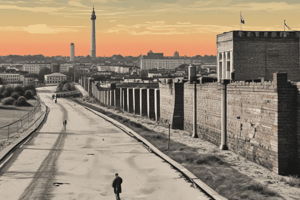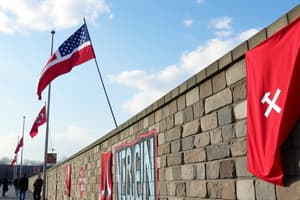Podcast
Questions and Answers
What was a significant reason people left East Berlin for West Berlin?
What was a significant reason people left East Berlin for West Berlin?
- A wish to travel to Western Europe
- Interest in a new political system
- Desire for more modern conveniences
- Escape from Communist leadership (correct)
Which notable figure was the mayor of West Berlin during the prosperous period of the 1950s?
Which notable figure was the mayor of West Berlin during the prosperous period of the 1950s?
- John F. Kennedy
- Walter Ulbricht
- Helmut Kohl
- Willy Brandt (correct)
What major action contributed to the poor state of East Berlin by the mid-1950s?
What major action contributed to the poor state of East Berlin by the mid-1950s?
- Collectivization policies (correct)
- A strong workforce
- Investment from the U.S. and Britain
- Protests against the government
Which country had direct command over East Berlin?
Which country had direct command over East Berlin?
What was a notable feature of West Berlin compared to East Berlin in the 1950s?
What was a notable feature of West Berlin compared to East Berlin in the 1950s?
What percentage of the East German population is estimated to have left between 1948 and 1961?
What percentage of the East German population is estimated to have left between 1948 and 1961?
What was one of the reasons initially believed by the East German government for the mass exodus?
What was one of the reasons initially believed by the East German government for the mass exodus?
What type of individuals comprised a large portion of those leaving East Germany?
What type of individuals comprised a large portion of those leaving East Germany?
What was the primary concern of East Germany regarding educated individuals leaving the country?
What was the primary concern of East Germany regarding educated individuals leaving the country?
What was the symbolic significance of educated individuals leaving East Germany?
What was the symbolic significance of educated individuals leaving East Germany?
What action did Walter Ulbricht seek from Khrushchev to prevent educated East Germans from leaving?
What action did Walter Ulbricht seek from Khrushchev to prevent educated East Germans from leaving?
When was the barbed wire barrier around West Berlin erected?
When was the barbed wire barrier around West Berlin erected?
What was one consequence faced by families when the barrier was erected?
What was one consequence faced by families when the barrier was erected?
What improvements were made to the initial barbed wire barrier?
What improvements were made to the initial barbed wire barrier?
What measures did the Eastern government implement to thwart the exit of individuals to the West?
What measures did the Eastern government implement to thwart the exit of individuals to the West?
What was the perception of Western governments when the barrier was first erected?
What was the perception of Western governments when the barrier was first erected?
Flashcards
Brain Drain
Brain Drain
The movement of highly skilled individuals from one country or region to another, often seeking better opportunities.
East German Brain Drain
East German Brain Drain
East Germany's effort to prevent its educated citizens from leaving for West Germany.
Symbolic Defeat
Symbolic Defeat
The symbolic defeat of East Germany as its intelligentsia chose to leave for West Germany, indicating a lack of support for the East German government and ideology.
Berlin Wall
Berlin Wall
Signup and view all the flashcards
Barbed Wire Barrier
Barbed Wire Barrier
Signup and view all the flashcards
Wall Improvements
Wall Improvements
Signup and view all the flashcards
Increased Enrollment
Increased Enrollment
Signup and view all the flashcards
Government's Response
Government's Response
Signup and view all the flashcards
Division of Berlin
Division of Berlin
Signup and view all the flashcards
Exodus from East Germany
Exodus from East Germany
Signup and view all the flashcards
West Berlin's Prosperity
West Berlin's Prosperity
Signup and view all the flashcards
East Berlin's State
East Berlin's State
Signup and view all the flashcards
Communist Policies in East Germany
Communist Policies in East Germany
Signup and view all the flashcards
Motivation for the Berlin Wall
Motivation for the Berlin Wall
Signup and view all the flashcards
The Berlin Wall
The Berlin Wall
Signup and view all the flashcards
Who Left East Germany?
Who Left East Germany?
Signup and view all the flashcards
Study Notes
Berlin Wall 1961
- The Berlin Wall was constructed in 1961.
- West Berlin was thriving in the mid-1950s.
- The US, Britain, and France rebuilt West Berlin.
- West Berlin had its own mayor (Willy Brandt) and used West German currency.
- West Berlin had modern conveniences like electricity, television, grocery stores, and retail shops.
- West Berlin was a prosperous and appealing city compared to East Berlin.
- East Berlin was under Soviet Union control and highly influenced by East Germany.
- East Berlin faced poverty and a poor state by the 1950s.
- Collectivization policies in East Germany led to a poor population.
- The Soviets didn't rebuild East Berlin and East Germany as well as the U.S. and Britain rebuilt West Germany and West Berlin.
- East Berlin was stripped of valuable items at the end of World War II.
- East Berlin lacked many modern conveniences like electricity and television.
- A large exodus of people left East Germany and East Berlin.
- Escape was easy from East Berlin to West Berlin since there was no border between them.
Exodus
- People left East Germany and East Berlin because they were unhappy with their lives under Communism.
- People didn't believe in Communism and the Communist leaders.
- Approximately 20-30% of East Germany's population left between 1948-1961.
- The most educated and skilled East Germans left, including teachers, professors, doctors, scientists, accountants, mechanics, artists, and engineers.
- The departing educated was a symbolic defeat for East Germany.
The Wall - Phase 1
- On August 13, 1961, a barbed wire barrier was erected around West Berlin.
- Checkpoints remained open but were regulated with passports and exit passes.
- Many people were caught unawares on that Sunday morning as they were visiting friends, family, attending church, etc.
- Western Governments were concerned that this action might be a prelude to an attack.
Status Quo and Wall Improvements
- The barbed wire was replaced by a concrete wall.
- The wall included death strips, car traps, guard towers, and guard dogs.
- The wall prevented emigration but symbolized the failure of the East Germans to persuade their citizens that Communism was a good idea.
Who Left?
- The most educated and skilled individuals, such as teachers, doctors, scientists, etc. left because they weren't satisfied with their lives in East Germany, or their lack of education, culture, and technological development in comparison to the West.
Studying That Suits You
Use AI to generate personalized quizzes and flashcards to suit your learning preferences.




